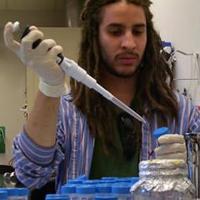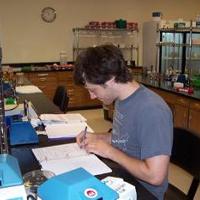 Patricia J. Hilleren
Patricia J. Hilleren
Associate Professor of Biology and chair
Address:
Biology Department - CIS 210A
Skidmore College
Saratoga Springs, NY 12866
Telephone:
(518) 580-8301
Fax:
(518) 580-5071
E-mail:
phillere@skidmore.edu
Office hours: Tuesday 10:30am-12noon and Thursday 2:15pm-3:30pm
Education:
- B.S. Microbiology (1987) St. Cloud State University, St. Cloud, MN
- Ph.D. Biochemistry, Molecular Biology, and Biophysics (1997) University of Minnesota, Minneapolis, MN
- Postdoctoral Research (1997-2003) Howard Hughes Medical Institute, University of Arizona, Tucson, AZ
Courses Taught:
- Liberal Sciences I (LS I)
- Molecular Cell Biology (BI 242)
- Chromatin Structure, Maintenance and Function (BI 360)
- mRNA Synthesis, Processing, and Turnover (BI 363)
Research Interests:
All cells share a set of fundamental processes (DNA replication, RNA and protein synthesis and cell division) that are each subject to quality control. This ensures that mistakes are recognized and dealt with before they can become a problem for the cell. Quality control is also important in the pathway of gene expression. In this pathway, newly transcribed pre-mRNA undergoes a number of processing steps that together yield a mature mRNA. These processing steps happen in the nucleus, in some cases, while the newly made pre-mRNA is still in very close proximity to its corresponding gene. Once processing is complete, the mRNA is exported from the nucleus into the cytoplasm of the cell where it can function in protein synthesis. Nuclear pre-mRNA processing steps are very fast and as a consequence of speed, mistakes can happen that yield defective mRNAs. If defective mRNAs are allowed to persist and accumulate in the cell, they could lead to the production of mutant or deleterious forms of proteins.
Fortunately, quality control systems are in place to recognize and degrade defective mRNAs. The best-characterized mRNA quality control systems operate in a translation dependent manner that works in the cytoplasm during protein synthesis. For example, mRNAs that carry early premature stop codons are detected and rapidly degraded by a pathway termed nonsense-mediated decay. Alternatively, mRNAs that are defective because they do not possess a stop codon are also recognized as aberrant and are rapidly degraded, in this case by the non-stop mediated decay pathway.
In contrast to the well-characterized cytoplasmic systems, quality control systems that operate during pre-mRNA processing in the nucleus are poorly understood, at best. Depending upon the nature of the defect, aberrant pre-mRNAs accumulate within the nucleus, in some cases at or near their sites of transcription. Why these aberrant RNAs accumulate near the gene, and how they are eventually removed remain puzzling questions.
Using the budding yeast, Saccharomyces cerevisiae, my research is aimed at understanding the mechanisms that underlie nuclear quality control systems that operate to ensure accuracy in gene expression. Current and future research projects address the following issues:
-
how aberrant RNAs are differentiated from normal mRNAs by the various degradation systems;
-
the mechanism by which some aberrant RNAs are retained at the site of transcription; and
-
the consequence to continued gene expression (if any) from the nuclear accumulation of aberrant RNA.
Publications:
Hilleren, Patricia and Roy Parker. (2003) Cytoplasmic Degradation of Splice Defective pre-mRNA and Intermediates: A Dbr1p-Dependent Quality Control System for pre-mRNA Splicing. Molecular Cell. 12:1453-65.
Hilleren et al., (2001) Quality Control of mRNA 3-end Processing is Linked to the Nuclear Exosome. Nature. 413:438-42.
Hilleren, Patricia and Roy Parker. (2001) Defects in the mRNA Export Factors Rat7p, Gle1p, Mex67p and Rat8p Cause Hyperadenylation During 3'-end Formation of Nascent Transcripts. RNA 7:756-64.
Hilleren, Patricia and Roy Parker. (1999) mRNA Surveillance in Eukaryotes: Kinetic Proofreading of Proper Translation Termination as Assessed by mRNP Domain Organization? RNA 5:711-719
Hilleren, Patricia and Roy Parker. (1999) Mechanisms of mRNA Surveillance in Eukaryotes. Ann. Rev. Genetics. 33:229-60.
Hilleren, Patricia J., Kao, Hung-Ying, and Paul G. Siliciano. (1995) The Amino-terminal Domain of Yeast U1-70K is Necessary and Sufficient for Function. Mol. Cell. Biol. 15:6341-50.
Pomeroy, Clare C., Hilleren, Patricia J., and M. Colin Jordan. (1991) Latent murine Cytomegalovirus DNA in Splenic Stromal Cells of Mice. Jour. Virology 65:-3330-04.



